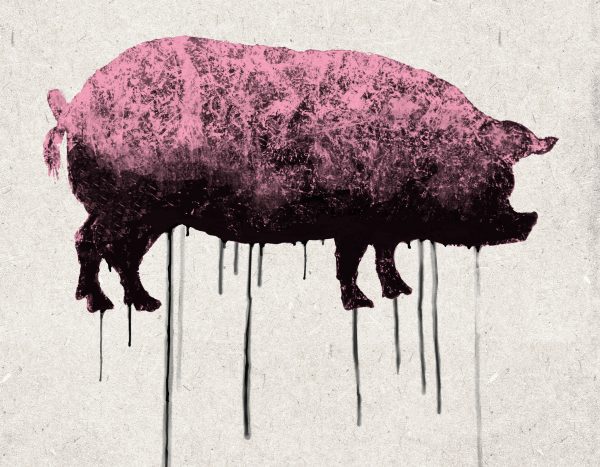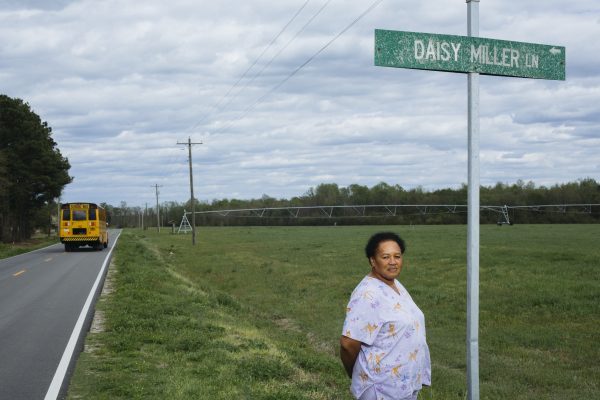Triad City Beat: Hogwashed

By Staff -June 28, 2017
A powerful special interest. Shameless politicians. Failed regulations. An in-depth look at Big Pork in North Carolina.
Editor’s Note: This is the first of a three-part investigation into North Carolina’s hog-farming industry. This story will examine claims by lower-income, African-American residents of eastern North Carolina that neighboring hog farms have polluted their properties as well as efforts by lawmakers to shield pork producers from litigation. The second story will look at the environmental impacts hog farming has had over the last two decades, particularly on waterways such as the Neuse River. The final piece will discuss ways to make the hog industry more sustainable, both for the environment and the state’s rural population, and the political and financial reasons those steps haven’t been taken. — Jeffrey Billman, editor in chief of Indy Week
by Ken Fine and Erica Hellerstein, photos by Alex Boerner
PART ONE: THE STENCH
I. ‘Nobody else will ever live on this land’
Rene Miller pokes a lavender-frocked leg out of her front door and grimaces. It’s a bright April afternoon, and the 66-year-old Miller, with a stoic expression and a dark crop of curls, braces herself for the walk ahead.
Her destination isn’t far away — just a half-mile down a narrow country road, flanked by sprawling green meadows, modest homes, and agricultural operations — but the journey takes a toll. Because as she ambles down the two-lane street, stepping over pebbles and sprouts of grass, the stench takes hold, an odor so noxious that it makes her eyes burn and her nose run. Miller likens it to “death” or “decomposition,” to being surrounded by spoiled meat.
As bad as it is today, she says, it’s nothing compared to the way it is on a muggy afternoon in August, when the stink hovering in the stagnant, humid air can nearly “knock you off your feet.”
Still, Miller makes this trip often to honor her family and pay her respects. She points ahead to her family cemetery, which sits just off Veachs Mill Road in Warsaw, a couple hours’ drive east from the Triad. It’s a stone’s throw from her one-story, white-walled house, part of a tract of land her great-grandmother inherited as part of a post-slavery land grant. When she gets to the cemetery, she stops in front of her nephew’s grave, recalling his life and his death to cancer. Purple and yellow wildflowers nip at its edges; nearby, a Steelers flag rustles in the wind.
“How long have we lived here? Always,” she says, gazing at her grandmother’s headstone. “And we always will. Nobody else will ever live on this land.”

Warsaw, North Carolina – Friday April 7, 2017 – Renee Miller grew up in the house where she now lives in Warsaw, NC. She is currently involved in a lawsuit against the hog farm which sprays hog waste from the farm onto a field across the street from her home where a sign bearing the name of her mother marks the road where she lives.
The odor isn’t just her problem. It’s ubiquitous across parts of eastern North Carolina. It’s the smell of hog country, of millions of pigs and even more tons of their feces. For years, their waste and its stink have been the subject of litigation, investigations, legislation and regulation. A growing body of research has documented the industry’s health and environmental risks. The issue has been well examined in the media, too. The New York Times and the Washington Post covered it. So have “Dateline” and “60 Minutes.” The News & Observer earned a Pulitzer Prize for reporting on it in 1995.
Nonetheless, the stench — and its consequences, both for the lower-income, largely African-American neighbors of the hog farms and the state’s environment — lingers. The obvious question — why? — has been at the heart of a months-long investigation that has led reporters to raucous legislative hearings, a tiny airplane and stories about death threats shared over a glass of sweet tea. This series will explore what Indy Week and Triad City Beat learned — and what can be done to solve North Carolina’s pervasive hog-waste problem.
II. ‘Recognized as environmental racism’
To understand Rene Miller’s predicament, you have to start with the pigs.
Their population in North Carolina has skyrocketed in recent decades. In 1986, North Carolina ranked seventh in the country in pork production; 30 years later, it’s second only to Iowa, with an estimated 9.2 million pigs on 2,217 hog farms, according to the US Department of Agriculture’s quarterly hog survey and the most recent US Census of Agriculture. The pigs have ushered in a $2.9 billion-a-year industry that employs more than 46,000 people in North Carolina, but those hogs also produce millions of tons of feces. In one year alone, an estimated 7.5 million hogs in five eastern North Carolina counties produced more than 15.5 million tons of feces, according to a 2008 report by the federal General Accounting Office.
Nowhere are the impacts more profound than in Duplin County, where Miller and about 2.3 million hogs live — more than anywhere else in the state, according to the Environmental Working Group, a research and advocacy organization.
A recent analysis of county and satellite data by the organization found that roughly 160,000 North Carolinians live within a half-mile of a pig or poultry farm; in Duplin, nearly 12,500 people — more than 20 percent of its residents — live within that range. If you extend the radius to three miles, as many as 960,000 North Carolinians fall into that category. That’s nearly 10 percent of the state’s population — more than Greensboro, High Point and Winston-Salem combined.
For Miller, these numbers aren’t abstractions. They’re her life.
“That scent is so bad,” she says. “You can’t go outside. You can’t go outside and cook anything because the flies and mosquitos take over.”
Within a mile of her property, Murphy-Brown LLC — a subsidiary of Smithfield Foods, the largest hog producer in the world — owns 5,280 hogs, according to the NC Department of Environmental Quality. Within two miles, there are more than 80,000 Murphy-Brown-owned hogs at seven different farms, according to a lawsuit she filed in 2014.
to continue reading, click here.